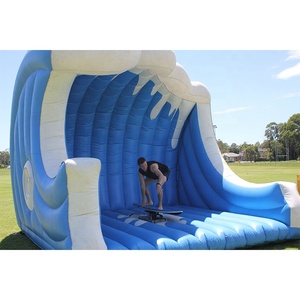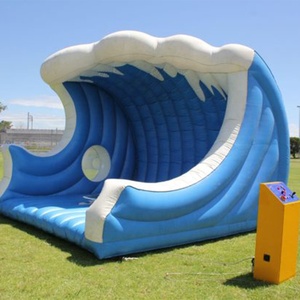(1271 products available)

































































































































































































































Indoor surfing equipment refers to a range of apparatuses and facilities that enable individuals to experience the thrill of surfing in an indoor setting. This equipment is designed to simulate ocean waves and provide a safe and controlled environment for both beginners and experienced surfers. The types of indoor surfing equipment include:
Indoor surfing equipment presents various opportunities for businesses looking to cater to different markets and customer preferences. Here are some key application scenarios:
Fitness Centers and Gyms
Indoor surfing equipment can be used as a unique and engaging workout tool in fitness centers and gyms. Surfset Fitness, for example, offers a surf training program that uses their indoor surfing equipment to provide a full-body workout that improves strength, balance, and cardiovascular fitness.
Water Parks and Recreation Centers
Water parks and recreation centers can add indoor surfing attractions like surf simulators or wave pools to provide visitors with thrilling and memorable experiences. These attractions can be suitable for all age groups and skill levels, making them a great addition to any water park.
Surf Schools and Training Facilities
Indoor surfing equipment can be used by surf schools and training facilities to help students develop their surfing skills in a controlled environment. Beginners can use artificial surfing equipment to learn the basics of surfing without the challenges and dangers of open water.
Indoor Surfing Facilities
Indoor surfing facilities can offer a variety of indoor surfing equipment to cater to different surfers' preferences and skill levels. From beginner-friendly wave generators to advanced surf simulators, these facilities can provide a year-round surfing experience.
Home and Personal Use
Indoor surfing equipment like balance boards and surf trainers can be used for home workouts and skill development. These tools can help surfers maintain their balance and improve their core strength, which are essential for surfing, even on non-surfing days.
Corporate Events and Team Building
Indoor surfing can be an exciting and unique activity for corporate events, parties, or team-building exercises. Companies can rent portable surf simulators for their events to provide attendees with a fun and memorable experience.
Therapeutic and Rehabilitation Programs
Indoor surfing equipment can be used in therapeutic and rehabilitation programs to help patients improve their physical strength, balance, and coordination. The low-impact nature of surfing makes it a suitable exercise for individuals recovering from injuries.
When purchasing indoor surfing equipment, business buyers should consider the following factors.
Space Requirements
Buyers should consider the space requirement of the indoor surfing equipment. They should get the required dimensions of the equipment and the installation area. Also, they should consider the height, width, and length of the equipment. This ensures the equipment fits properly in the intended space.
Skill Level Adjustability
Buyers should get equipment that has adjustable difficulty levels. Such equipment enables users to start as beginners and gradually increase the difficulty level as they gain confidence and improve their skills.
Safety Features
Business buyers should prioritize equipment with safety features. For example, non-slip surfaces and protective padding. Such features help to reduce the risk of injury especially for beginners.
Type of Equipment
Indoor surfing is done on different types of equipment. For instance, surf simulators, wave machines, and balance boards. Buyers should familiarize themselves with the different types and their appeal to different customers.
Quality and Durability
Business owners should get equipment constructed with high quality materials. Also, they should look for equipment that can withstand regular use to avoid frequent replacements.
Maintenance and Upkeep
Buyers should consider the maintenance requirement of the indoor surfing equipment. They should get equipment that is easy to clean and maintain to ensure longevity and optimal performance.
Cost and Budget
Business buyers should consider their budget and the overall cost of the indoor surfing equipment. This includes initial cost, installation, maintenance and potential repair costs. They should also consider the cost in relation to the quality and features of the equipment.
Realism and Experience
Buyers should look for equipment that offers realistic surfing experience. For example, equipment with adjustable water flow speed and incline settings. This will enhance the user's experience and improve their surfing skills.
Additional Features
Buyers should consider additional features that make the indoor surfing more enjoyable. For instance, integrated sound systems or interactive digital displays. Such features can enhance the surfing experience and provide additional training tools.
Below are the features, functions and design elements of indoor surfing equipment
Training Tool
Indoor surfing equipment can be used as a training tool. Beginners can use the equipment to practice surfing techniques. Moreover, experienced surfers can use it to refine their skills.
Entertainment
Indoor surfing equipment offers an exciting and fun experience for users. This adds to the overall appeal of indoor surfing.
Space Optimization
Indoor surfing equipment is designed to fit into smaller spaces. This allows people without open spaces to enjoy surfing.
Adjustable Wave Height
Some indoor surfing machines come with adjustable wave heights. This feature allows users to customize the wave height to their skill level.
Non-Slip Surface
The surfaces of indoor surfing equipment are designed to be non-slip. This provides stability and safety for users while surfing.
Realistic Surfing Experience
The indoor surfing equipment is designed to provide a realistic surfing experience. For instance, artificial waves are generated through various mechanisms.
Compact Design
Most indoor surfing machines have a compact design. This makes them easy to store and set up in indoor spaces.
Durable Materials
Indoor surfing equipment is made from durable materials. This includes fiberglass, stainless steel, and reinforced plastics. These materials can withstand the wear and tear of surfing.
Integrated Safety Features
Indoor surfing equipment is designed with integrated safety features. For instance, guardrails or pads that prevent users from falling off the machine.
Q1: What does indoor surfing mean?
A1: Indoor surfing refers to surfing on an artificial wave in a controlled environment. This can be done on a surf simulator or a wave generator, which provide a safe and consistent surface for surfing.
Q2: What are the benefits of indoor surfing equipment?
A2: Indoor surfing equipment offers several benefits, including providing a safe and controlled environment for beginners to learn surfing without the risks associated with ocean surfing. It also offers a consistent wave experience, allowing surfers to practice and improve their skills year-round without dependence on weather or travel conditions. Moreover, indoor surfing is a fun and engaging activity that provides a full-body workout, improving strength, balance, and cardiovascular fitness.
Q3: What factors should be considered when buying indoor surfing equipment?
A3: Several factors should be considered when purchasing indoor surfing equipment, including the space required for setup, the level of maintenance needed, the type of surf experience offered (beginner or advanced), and the equipment's durability and quality. It's also essential to consider the target user group—whether the equipment will be used by beginners, experienced surfers, or for commercial purposes.
Q4: What is the difference between a surf simulator and a wave generator?
A4: A surf simulator is a device that creates an artificial surfing experience on a flat surface, allowing users to practice surfing skills. In contrast, a wave generator creates artificial waves in a pool or similar environment, enabling surfers to experience real surfing conditions.
Q5: Who can use indoor surfing equipment?
A5: Indoor surfing equipment can be used by people of all ages. Beginners can use it to learn how to surf, while experienced surfers can use it to practice their skills. Other people use the equipment for fitness and recreational purposes.